Browse Houses
Search Results: Returned 5927 records. Displaying results 4701 – 4800
| House name | Description | |
|---|---|---|
| Raghly Lodge | Raghly Lodge was held in fee by Charles Gore Jones at the time of Griffith's Valuation, when it was valued at £10 10s. In 1894 it was also noted as his residence by Slater. McTernan notes that it was remodelled in the early twentieth century and raised to two storeys. It remained in the Jones family until c.1912. It is still extant and occupied. | |
| Rahans | On the 1st edition 6 inch Ordnance Survey map (1836) Rahans is marked with a courtyard and pump at the back of the house. John Read or Reed was the occupant at this time and was still resident at the time of Griffith’s Valuation when the buildings were valued at £32. By the early 20th century Rahans was the home of Dr Peter McKenna. It is no longer extant. | |
| Rahans | The home of the Atkinson family, Wilson notes in 1786 that it was the residence of Charles Atkinson and "very pleasantly situated". It was occupied by the rector of Crossmolina, the Reverend Edwin Stock, for a few years prior to 1815. Rahans was described in 1855 as "a comfortable dwelling house, in a fair state of repair" and occupied by Mrs Frances Atkinson. At the time of Griffith's Valuation it was the home of George Orme. In 1925 Adelaide R. Orme of New South Wales sold Rahans demesne to Patrick J. Ruttledge of Ballina for £3,000, [see Acc. 1165/8/11 National Archives.] It is no longer extant. | |
| Rahara | In the 1830s and at the time of Griffith's Valuation the home of Alexander Sproule who held Rahara from the Blake Knox family. The house was originally a thatched one storey building. On the night of the Big Wind in 1839 the thatch was blown away and the house was rebuilt with an additional storey and a slate roof. Now the home of the Donnelly family. |

|
| Rahasane | In 1786 Wilson refers to Rahasane as the seat of Mr. French. Lewis records Rahasane as the seat of R.French in 1837. Held in fee by Thomas A. Joyce at the time of Griffith's Valuation when it was valued at £45. The Landed Estates court sale notice of June 1871 mentions that Rahasane House was built by Robert Joseph Ffrench at a cost of £10,000. This, the original Rahasane House , is described as " in ruins" on the 25-inch Ordnance Survey map of the 1890s. A later Rahasane House is shown on the 1933 ediiton of the six-inch Ordnance Survey map, located in Pollnagerragh West townland, (M474172). While there is no trace now of the original house built by R.J. French, some estate architecture survives. |
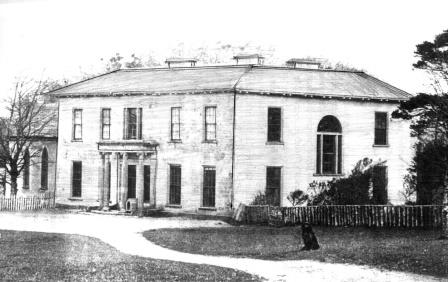
|
| Raheen | At the time of Griffith's Valuation, Clifford Trotter was leasing a property valued at £7 along with 284 acres to James Lynam. This property is still extant and occupied. |
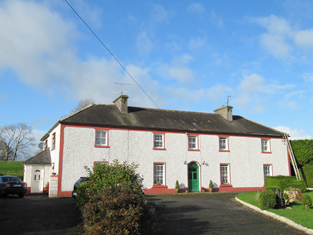
|
| Raheen | Raheen is associated with both the Kilkelly and O'Hara families. In the 1770s it seems to have been a residence of the Taylor family, with whom the O'Haras intermarried. In the 1830s the OS Name Books record it as "a neat house, in form like a cottage two stories high." Raheen House was badly damaged by fire in the latter part of the twentieth century. The entrance gateway is still extant. |

|
| Raheen | This was the home of the Brady family from the mid 18th century. In 1837 Reverend Thomas B. Brady occupied the house. By the time of Griffith's Valuation William Moreland was in possession and the house, offices and mill valued at £4.10 shillings were leased to Patrick Flynn. In 1906 buildings at Raheen ,which included a mansion house and 401 acres of untenanted land belonging to Robert W. Moreland, were valued at £37. In 1908 the property was bought by S.R. MacLysaght of Mallow, father of Dr Edward MacLysaght, genealogist. The Irish Tourist Association Survey file refers to Raheen Hospital beautifully situated amid a large forest on the shores of Lough Derg. The house no longer exists. | |
| Raheen | A steward's house on the Bourke estate was recorded at Raheen in the early 1850s. It was valued at £11+. | |
| Raheen | Occupied by Major Fawcett in 1837 and by John Irwin in the mid 1850s who held the property from Francis Murphy. In 1840 John Irwin had married Margaret Harken of Raheen House, Elphin. |

|
| Raheen (Athenry) | Raheen House is associated wth the Lopdell family although there was only a herd's house valued at £3 and gate lodges recorded there at the time of Griffith's Valuation. In 1894, however, Slater noted it as the residence of Mrs. Lopdell. Raheen is still extant. |
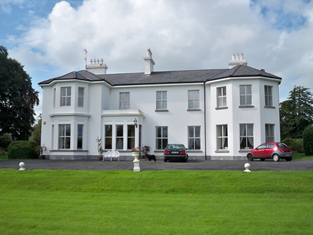
|
| Raheen (Gaultiere) | In 1848, Michael Nugent was leasing this property from Lord Waterford's estate when it was valued at £13. A house and farm still exist at the site though the original house does not appear to be extant. | |
| Raheen House (Clonmel) | Held in fee by Mrs. Elizabeth Greer at the time of Griffith's Valuation, when it was valued at over £55. It was offered for sale in September 1878 on behalf of William Greer, described as a lunatic, by his guardians. | |
| Raheen House (Kinalmeaky) | Held by Augustus Warren but unoccupied at the time of Griffith's Valuation,when it was valued at £9. Noted by Leet as the property of William Warren in 1814. The original house is no longer extant. | |
| Raheen Park | Located south east of Farneybridge this house was occupied by Edward Wilson in the mid 19th century, valued at £34 and held from William B. Armstrong. Raheen Park may have been previously known as Brasfort. Brasfort was the home of the Wilsons in the 1830s. Edward Wilson was Chief Magistrate of Police in county Tipperary in the 1820s. In 1820, his son, Edward Wilson, married Isabella, daughter of Thomas Goodricke Peacock of Fort Etna and they had a son, Thomas Goodricke Wilson, who married Mary Studdert in 1861 and emigrated to Canada. In 1840 the Ordnance Survey Name Books refer to E. Wilson as the proprietor of Raheen Park. Edward Wilson of Raheen Park died at Monkstown, county Dublin in 1880, aged 81, (see D.23260 in the National Archives). | |
| Raheens | A house south west of Castlebar, noted by Wilson as the seat of A.N. Browne in 1786. Held by the Browne family from their relatives the Lords Kilmaine. At the time of Griffith's Valuation, it was occupied by Henry Browne and valued at over £16. It is now a ruin. |
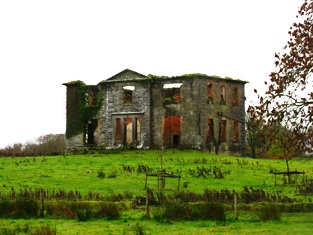
|
| Rahelly | Francis Barber was leasing a house at Rahelly, barony of Carbury, from the Gore Booth estate at the time of Griffith's Valuation, when it was valued at £25. Rahelly later fell into ruin but has been restored and offered for sale in recent times. |

|
| Rahoon House | In 1786 Wilson refers to Rahoon as the seat of Mr. French. In the early 19th century it was a Bodkin house, occupied by Roderick O'Connor at the time of the first Ordnance survey. It was held in fee by Thomas C. Dickson at the time of Grifith's Valuation and valued at £27. This house was bought by Kennedy O'Brien in the early 1870s and remained in his family's possession until the 1930s. Buildings are still extant at the site. |
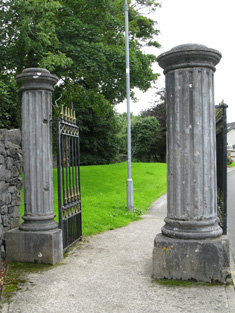
|
| Rahugh House | Located close to a graveyard and ruined monastery, Rahugh House is named on both the first edition six inch and the 25 inch OS maps. William Bagnell lived here in 1814. James Bagnell was the occupant at the time of Griffith’s Valuation (publ. 1854), holding the house, valued at £13.5 from Charles B Marlay. On 9 May 1873 the estate of William Bagnall, a minor, at ‘Rahue and Knockroe’ was for sale in the Landed Estates Court. The petitioner was Abraham Bagnall. The house was described in the sale rental as a ‘Substantial dwelling house’ and had ‘commodious out-offices’. At the turn of the 20th century Walter Newburn, a farmer and his family were resident and in 1911 James L Hodgins, also a farmer and his family were living at Rahugh. The house is extant. | |
| Raigh Lodge | At the time of Griffith's Valuation the house held by Nathaniel P. Simes in fee, was valued at £6. The premises shown at this site on the 25-inch Ordnance Survey map of the 1890s is labelled Clew Bay Hotel. A house is still extant and occupied here. |
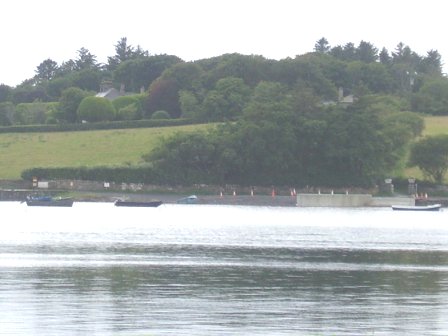
|
| Rakenny/Rathkenny House | A two storey square block of a house built in the late 1820s for Theophilus Lucas-Clements to the design of William Farrell. According to Bence Jones it was built with money given to Theophilus ‘by his cousin, Harriet, whose father, Captain John Clements, made a considerable fortune commanding a ship in the East India Company service’. A previous Clements home had been located on the other side of the Annalee River, of which the 18th century demesne and tea house survive and a walled garden dating back to 1695. Rakenny is the name of the house on the first edition six inch Ordnance Survey map (publ. 1837) but the house is commonly known as Rathkenny. It had a rateable valuation of £48.5.0. in the mid-19th century. Rathkenny House continued to be the home of the Lucas-Clements family until it was put up for sale in 2012 (Irish Times, 10 May 2012). | |
| Raleigh | In 1837 Raleagh was the residence of W. Minhear. James Minhear was occupying this house in the mid 19th century. He held it from the representatives of - Carleton and it was valued at £20.10 shillings. | |
| Rampart [Ards Farm] (Kilmacrenan) | In 1906 Eva D. Stewart was the owner of buildings valued at £48 in the townland of Clonmore, parish of Clondahorky, County Donegal. At the time of Griffiths Valuation this property was known as Rampart and was occupied by Thomas Ingram, leasing from the Stewart estate. On the later Ordnance Survey maps a much larger complex of buildings is labelled Ards Farm. The original buildings are no longer extant. | |
| Rantavan | Rantavan is situated on the southern side of the village of Mullagh and is named on the first edition six inch Ordnance Survey map (publ. 1837). Throughout the 18th century it was the home of the Brookes, a literary family. By the time of Griffith’s Valuation in the mid-1850s Jane Kellett was resident. She held the property from the representatives of John Young. The rateable valuation was £13.10.0. Home of the Roundtree family in the early 20th century this house appears to be still extant. | |
| Raphoe Bishop's Palace | William Ker was leasing this property from the Ecclesiastical Commissioners estate at the time of Griffiths Valuation in the 1850s, when the buildings were valued at £45. The Bishop's Palace was destroyed by fire in 1838 and has remained a ruin ever since. |
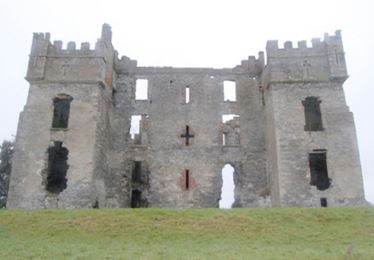
|
| Rapla | Rapla was a Freeman home in the 18th century and was inhabited for a time by the Otways, Phoebe Otway having married Daniel Freeman of Rapla. Wilson, writing in 1786, refers to Rapla as the seat of Mr. Willington. Jonathan Willington, younger brother of John of Killoskehane, was residing at Rapla in 1814 and William Cooper Crawford in 1837. William Cooper Crawford married Sophia Morgan [nee Willington] as her second husband. By the early 1850s John Tuthill was resident holding the house valued at £42+ from William Cooper Crawford. The sale rental of 1850 describes Rapla as a first class house held on a lease for 7 years from the Court of Chancery to John Tuthill. This house no longer exists. |

|
| Rappa Castle | An old Bourke castle, granted to a Cromwellian soldier named Crofton. It passed into Knox ownership through marriage and was the seat of this influential branch of the Knox family throughout the 18th and 19th centuries. In 1786 Wilson refers to it as "the pleasant seat of Mr. Knox". At the time of Griffith's Valuation it was held in fee by Annesley Knox and valued at £30. Slater notes it as the seat of Captain Annesley Knox in 1894. Occupied by the Knox family until the early 20th century, the house is now a ruin. |
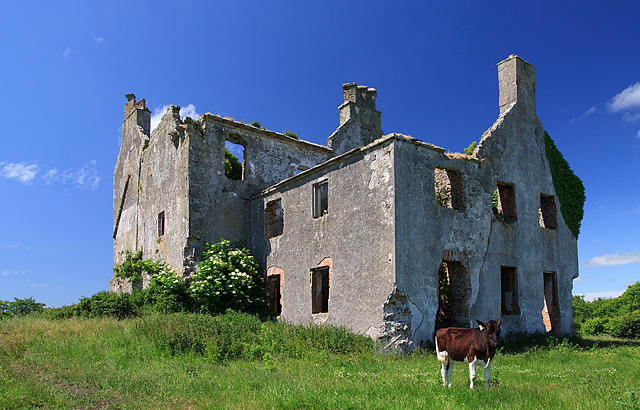
|
| Rath | Smith writes in 1750 that Rath was built by Alderman James French of Cork. Rath house was occupied by Michael Greene in the early 1850s and held from Sir Edward Tierney. It was valued at £12. To the north Rath Cottage (Grid Ref R492 147) was held by Sir Edward Tierney in fee and was valued at £14. This cottage is now a ruin and Rath House although still extant is no longer lived in, a new house having been built on the site. | |
| Rath (Fenoagh) | In 1850 Jane Bolton was leasing this property to Anne Power when it was valued at £12 15s. A farm still exists at the site. | |
| Rath House | In 1851 John Carroll was leasing this property from the Devonshire estate when it was valued at £16. Labelled as Rath House on the later 25-inch Ordnance Survey Map. | |
| Rath House | Rath House, was the home of J West in 1837 and of Thomas West at the time of Griffith’s Valuation (publ. 1854), when the buildings, including a corn mill, were valued at £34 and held from Alicia O’Connor Malone. In 1906 the mansion house of Rath valued at £30 was in the occupation of Colonel John R Malone and was held with 62 acres of untenanted land. The census records would suggest that the local rector Rev Venn was actually resident. The house is now demolished. | |
| Rath More House | At the time of Griffith's Valuation, Rev. Edward Walsh was leasing this property from Daniel Coltsman [Cronin], when it was valued at £17. In 1837 Lewis notes that Rathmore House was the property of D. Cronin but "now occupied by a society of monks". These were Cistercian monks, afterwards located at Mount Mellerey in county Waterford. The Cronins had lived at Rathmore until the early years of the nineteenth century before leasing it to the Order. After the monks departed it was used as the local presbytery and part of it is still extant. Denis Glissane was leasing a house in the same location from the Cronin estate, valued at £8. | |
| Rath-healy | In 1786 Wilson refers to Rath-hely as the seat of Mr. Bryan. It was the home of Arthur Hyde Lucas and his son and namesake in the 19th century. Arthur Hyde Lucas is recorded as occupier at the time of Griffith's Valuation, holding the property from John Hyde when it was valued at £20. In 1880 the property passed to Henry John Lucas, nephew of the second Arthur Hyde Lucas. Sold by the Lucas family in the 1920s and still inhabited. | |
| Rathanna | Col. Knox Barrett held this property from Jane Mullin at the time of Griffith's Valuation when it was valued at £20. It remained in the Barret family until the early 1900s when it was sold to the Monahan family who owned it until the 1960s. McTernan writes that it was sold to the Jurys Hotel Group who built the Sligo Park Hotel in front of the original house which was demolished in the 1980s. | |
| Rathanna | ||
| Rathanny | A house situated on the estate of the Earl of Limerick, occupied by John Sheeran in 1814 and by T. Bennett in 1837. Thomas F. Bennett was still resident at the time of Griffith's Valuation when the buildings were valued at £15. |

|
| Rathanny House | Elizabeth Rowan was leasing a property to Patrick Holohan at the time of Griffith's Valuation, when it was valued at almost £3. Lewis refers to Rathanny as the residence of Mrs. Rowan in 1837. In the 1830s the Ordnance Survey Name Books noted the house, built c.1730, as the residence of Mrs. Rowan In 1786 Wilson mentions Ratanny as the seat of Mr. Rowan. Bary states that the house was built by the Rowan family in the eighteenth century and lived in by them for much of the early nineteenth century. It was sold in the early twentieth century and is still extant and occupied. |
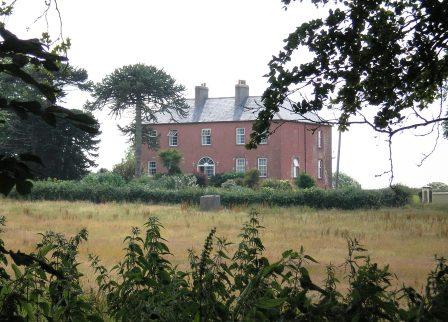
|
| Rathbarry Cottage | Rathbarry Cottage was occupied by Major William Love Peard at the time of Griffith's Valuation. The property was held from the Reverend R. Gumbleton and the buildings were valued at £11. Some ruined walls remain at the site. | |
| Rathbarry Vicarage/Rectory | Lady Carbery was leasing Rathbarry Vicarage to Rev. H. Stewart at the time of Griffith's Valuation, when it was valued at £20. Labelled as Rectory on the later 25-inch Ordnance Survey map, it is now known as Rathbarry House. |

|
| Rathbaun | Home of Simon P. Creagh in 1814 and of his son Pierce Creagh in 1837. Occupied by John Hickey at the time of Griffith's Valuation who held the house from Pierce Creagh. The house is no longer extant. | |
| Rathbennett House | Rathbennett House, formerly known as Farra House, originally functioned as Bunbrosna Charter School. Built c.1758 with a bequest from the will of the Rev. William Wilson, the nephew and heir of Andrew Wilson, the benefactor of Wilson's Hospital. Farra Charter School is recorded by Lewis in 1837 and was still recorded as a charter school with offices at the time of Griffith’s Valuation (publ. 1854) when the building was valued at £30. It was held by the trustees of Wilson’s Hospital in fee. Sometime later it became a private residence. Occupied by Thomas Cartret Foster in 1901 and 1911, this house remains a family home. |
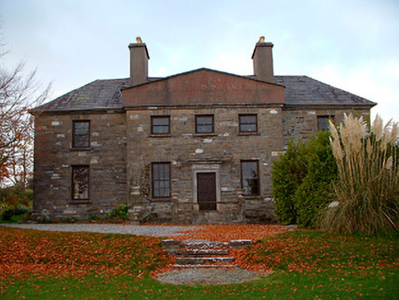
|
| Rathbraughan | The 1st edition OS map indicates the house at this location was known as Auburn Cottage. At the time of Griffith's Valuation it was occupied by Edward Smith {Smyth] leasing from William Green and valued at £23. McTernan writes that Smyth was the agent for Lord Palmerston's estate. At times it was leased by members of the Gethin family. It was demolished in the 1980s when Rathbraughan housing estate was built. | |
| Rathcam or Lemongrove House | Rathcam House, previously known as Lemongrove, is a four-bay two-storey house, built about 1830 to replace an earlier house. Lemmongrove is marked on the Taylor and Skinner maps of the late 1770s occupied by Wilton Esq. Joseph Lemmon of Lemmongrove is mentioned in a deed of assignment dated 1771. Leet records Joseph Lemon of Lemongrove in 1814. Valued at £18, it was occupied by John ‘Lennon’ at the time of Griffith’s Valuation (publ. 1854) and held from Christopher Wilson [Wilton?]. The Lemons were still resident at the beginning of the 20th century. John D Lemon was the occupant in 1906 when the mansion house was valued at £23 and held with 262 acres of untenanted land. |
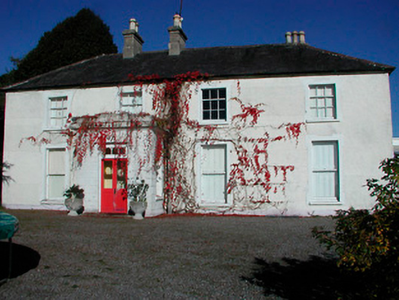
|
| Rathcarrick | At the time of Griffith's Valuation there were two substantial houses at Rathcarrick, barony of Carbury, both belonging to the Walker estate. John McHutcheon was leasing one property valued at £18 while Amy Eliza Walker was leasing the second, valued at £28. In 1906 John F. Walker was the owner of a house at Rathcarrick, then valued at £63. Rathcarrick house is still extant and has recently been renovated. |

|
| Rathcastle | An early 19th century three-bay two-storey over a basement house, named on the first edition OS map. Rathcaslin was the residence of Thomas Banon, in 1837. By the time of Griffith’s Valuation (publ. 1854) George Murdoch occupied the house valued at £23 from John Devenish Meares. Home of William Brabazon in 1901. It was still in the possession of the Meares in 1906 and is still extant. |

|
| Rathclare | Clare Cottage was originally a residence on the Egmont estate which Hajba writes was leased to the Norcott family. Occupied by Martha Bullen in the early 1850s when the house was valued at £13. A much larger house was constructed in the mid 19th century incorporating the original building. By the end of the 19th century the home of the Burdon family who were still resident in 2002. In 2012 it was being offered for sale. |

|
| Rathcline House | St. George Johnston was leasing this property from Colonel Henry White’s estate at the time of Griffiths Valuation in the early 1850s when it was valued at almost £38. Earlier, in 1837, Lewis referred to it as the seat of L. White. The National Built Heritage Service suggests the current house was built c.1820 though there is evidence to suggest there was an earlier house, also owned by the White family, at the site in the 1770s. Rathcline House served as a convent for the Sisters of Mercy in the mid-20th. It is still extant. |
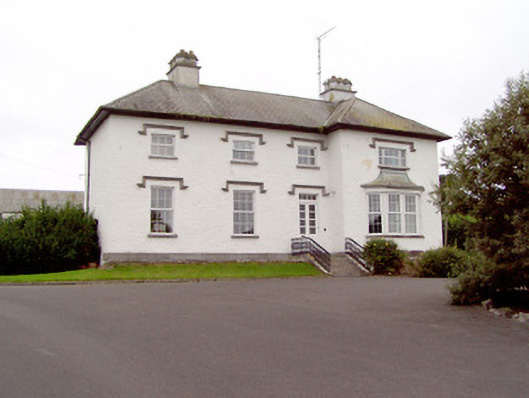
|
| Rathclogh Cottage | A small residence when marked on the first Ordnance Survey map. Occupied by Charles Minchin in 1850, valued at £13+ and held from John Millett. | |
| Rathcloheen | Rathcloheen was the home of John Mathew in the first half of the 19th century. The house is situated very close to Thomastown Castle. At the time of Griffith's Valuation John Mathew held Rathcloheen from Lynn Carew and the buildings were valued at £20. "Burke's Irish Family Records" refers to John Smithwick of Rathclogheen, county Tipperary who married Cherry Pennefather in 1823. This house is well preserved and is still used as a residence. |

|
| Rathconnell Court | Rathconnell Court is named on the first edition OS map and marked as ruins on the 25 inch map of the early 20th century. It was the home of the Adams family and was marked on the Taylor and Skinner maps of the 1770s. Occupied by Francis Adams in the early 19th century and by J Adams in 1837. Francis Adams was resident at the time of Griffith’s Valuation (publ. 1854) holding the house valued at £18 in fee. | |
| Rathcool | Blake Esq was resident at Racool in the 1770s. In 1840 the Ordnance Survey Name Books describe Rathcool as "a castle apparently inhabited. There is another dwelling house attached with a garden". In the mid 19th century Rathcool Castle was occupied by Charles Blackmore and held from the representatives of L. Clutterbuck. The buildings were valued at £16.13 shillings. Charles Blackmore was still residing at Rathcool in the 1870s when he is recorded as the owner of one acre in county Tipperary. Rathcool is still in use as a house. |
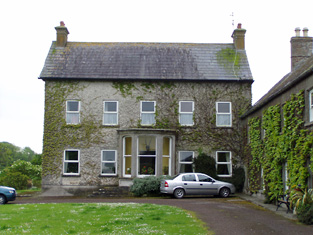
|
| Rathcormac | In 1786 Wilson refers to "Rathcormuck" as the seat of Lord Riversdale. | |
| Rathcoursey House (East) | At the time of Griffith's Valuation a house in Rathcoursey East valued at £18 was held by Richard Lyons from the Provost and Fellows of Trinity College, Dublin. This house is still a residence. |

|
| Rathcoursey House (West) | Home of the Smith family in the 18th and 19th centuries. John Tynte Smyth lived here in the 1770s. Occupied by John Smith in 1814 and John J. Smyth in the early 1850s. The house was valued at £35 and held from the Marquess of Thomond with 214 acres. It is now run as a guest house. |

|
| Rathdonnell House | James Hamilton was leasing this property from the estate of Reverend William Alexander at the time of Griffiths Valuation in the 1850s when it was valued at £7. Local sources suggest it had come into the Alexander family through their mother, Dorothy McClintock. | |
| Rathduane | The home of Owen McCarthy in 1814, of J.E. McCarty [Jeremiah Eugene] in 1837 and of Eugene McCarthy at the time of Griffith's Valuation when the buildings were valued at £20 and held from Sir Broderick Chinnery. Still a McCarthy home in the 1870s. | |
| Rathduff | A house occupied by Thomas Kennedy and held from the Reverend John W. Hackett and partners in the mid 19th century when the buildings were valued at £16.15 shillings. | |
| Rathellen | McTernan writes that Rathellen was built at the beginning of the nineteenth century as a dower house for the Wood of Woodville estate.. It was purchased by Henry Lyons in 1860 and remained in the Lyons family until the 1940s. It is still extant but unoccupied. | |
| Rathfadden Cottage | In1850 this property was leased by Joshua W. Strangeman from the Corporation of Waterford. | |
| Rathfranpark | ||
| Rathfranpark | In 1894 Slater refers to Rathfranpark as the residence of Edmund Knox. At the time of Griffith's Valuation this townland was part of the Palmer estate and leased by Thomas Scott. The house on the property at that time was valued at almost £2. There is still a house at this site. | |
| Rathfredagh | This house was erected post Griffith's Valuation. The Irish Tourist Association surveyor dates it to about 1870. It was the home of James Waller O'Grady a grandson of the 1st Viscount Guillamore and of the 3rd Baron Massy. In 1906 Richard O'Grady, eldest son of James Waller O'Grady (born 1867) was living here. The house was valued at £41.15 shillings. Seat of the 8th and 9th Viscount Guillamore and in the mid 1960s the O'Gradys gave this house to the Cheshire Homes Foundation. It opened as the fifth Cheshire Home in Ireland in 1971. http://www.cheshire.ie/centres_rathfredagh.asp |

|
| Rathglass | In 1814 Rathglass House was the residence of Bernard Rochford. In November 1850 Mark Lynch was occupying the house. At the time of Griffith's Valuation it was occupied by James M. Bourchier. It is still extant. |
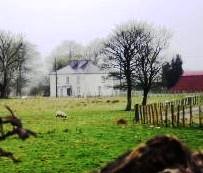
|
| Rathgormuck Castle | The buildings in the vicinity of Rathgormuck Castle were valued at £10 in 1850 and leased by Walter Mansfield to Thomas Terry. On the first edition Ordnance Survey map the castle is described as "in ruins". | |
| Rathgranagher | A house on the Lindsey estate, lived in by Charles Cromie in the late 1830s. It was occupied by John Jackson at the time of Griffith's Valuation, leasing from Thomas Lindsey, when it was valued at £14. A house is still extant there. |

|
| Rathkeale Abbey | The residence of J. Hewson in 1837 and previously of the representatives of George Lake [Leake] esq. By the time of Griffith's Valuation the Abbey was in the possession of Daniel Griffin who held it from the representatives of William Lake [Leake]. It was valued at £30. Referred to in 1942 as "a substanial well kept mansion" the property of Major Waller. |
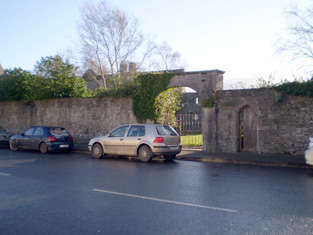
|
| Rathkeery Glebe | Rev. William French was leasing a glebe house at Glebe East, barony of Frenchpark, from Lord de Freyne's estate at the time of Griffith's Valuation when it was valued at £7. The house no longer survives but an entrance gateway and trees indicate its whereabouts. |

|
| Rathlaheen House | A pink three storey house, home of a branch of the Vandeleur family in the 18th and early 19th centuries. In 1786 Wilson refers to it as the seat of Boyle Vandeleur. Also occupied by Boyle Vandeleur in 1814 and by John Scott Vandeleur in 1837 according to Lewis. It was the centre of the famous Rathlaheen Co-operative in the early 19th century. Following the bankruptcy of John Scott Vandeleur in the 1830s Pierce Creagh occupied the house holding it from the Vandeleurs. It later became a Stoney home. They were resident in 1906. The house is no longer extant. | |
| Rathlee | At the time of Griffith's Valuation Thomas Jones was leasing a property valued at £18 at Rathlee, barony of Tireragh, to John Christie. The ''Sligo Directory'' of 1862 indicates that John Christie was a magistrate for the county. McTernan states that this property was associated with the Hewitt family who were connected with the Fitzgerald family through marriage. The Fitzgeralds had acquired an interest in the property at the beginning of the nineteenth century. In 1814 Leet recorded the house at Rathlee as the residence of Michael Fitzgerald. Rathlee is no longer extant but the remains of the walled garden are still visible. | |
| Rathluby | By the end of the 18th century Rathluby was in the possession of the Bridgeman family. The buildings were valued at £5 at the time of Griffith's Valuation when Henry Bridgeman occupied the house which he held from Eliza Piercey and it continued to be a Bridgeman home until the end of the 19th century. The house is now a ruin. | |
| Rathmagurry House | The 1st edition OS map indicates Rathmagurry House at Rathmagurry in Achonry Parish. At the time of Griffith's Valuation William Gawley was leasing a herd's house valued at £2 from the Knox estate at this location. The house is no longer extant. | |
| Rathmaher | Originally a Purcell home which was advertised for sale in May 1850. By the time of Griffith's Valuation this house was owned and occupied by Thomas Wise, valued at £33. In 1944 the Irish Tourist Association Survey reported that this house had been built c.1800 by John Purcell originally of Highfort. It was later occupied by Walpole and Smith families. This house is now a ruin. | |
| Rathmanna | Thomas Ryan of Rathmanna died in 1835 and is buried in the graveyard of St Mary's Church, Thurles. Rathmanna house was occupied by Thomas Ryan in the mid 19th century and held from Messrs Waller and Doherty on a lease dated 1791 James Doherty to Thomas Ryan. It was valued at £22.17 shillings. In 1865 it was advertised for sale with about 340 acres belonging to Thomas Ryan. Rathmanna a substanial and spacious house was in the possession of Michael Cahill in 1873. A building is still located at this site. | |
| Rathmeel | The representatives of William Ormsby were leasing a property valued at £12 at Rathmeel, barony of Tireragh, to Augustus Bolton at the time of Griffith's Valuation. Extensive modern development has taken place in this area. | |
| Rathmore | The property at Rathmore was the residence of Major McCann in 1814. At the time of Griffith's Valuation it was occupied by James McDermott, a family with which it was associated for many years. It had also been recorded as his seat by Lewis in 1837. Earlier, in 1783, Taylor and Skinner recorded it as a seat of the Browne family as did Wilson in 1786. In 1906 it was owned by James McDermott. The house at Rathmore, though smaller than originally, is still extant and occupied. The gatelodge is also extant having undergone extensive renovation. |
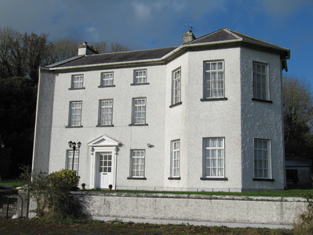
|
| Rathmore House (Ballymahon) | Robert C. Barbar was occupying this property, then valued at over £12, at the time of Griffiths Valuation. Lewis had also noted it as his seat in 1837. It was leased from the King Harman estate. This property was labelled Rathmore House on the 1st edition Ordnance Survey map but a later house (Grid Reference N150546) carries this label on the 25-inch edition of the early twentieth century. The latter is still extant. |
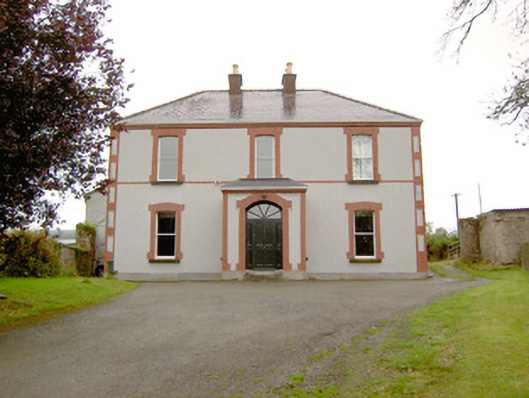
|
| Rathmore House (Kinsale) | Marmaduke Cramer held Rathmore House in fee at the time of Griffith's Valuation, when it was valued at £40. Lewis described it as " a handsome mansion embosomed in flourishing plantations" in 1837 when it was the seat of J. Thomas Cramer. This house is no longer extant. | |
| Rathmoyle | Richard Irwin was leasing a property valued at £35 at Rathmoyle, barony of Castlereagh, from George H. Kirkaldy, at the time of Griffith's Valuation. This property was also recorded as the residence of Richard Irwin in both 1814 and 1837. In 1749 the Census of Elphin recorded that Arthur Irwin, farmer, resided at Rathmoyle. Gormley states that the property continued in the possession of the Irwin family until 1921. The final distribution of land from this estate took place in 1969 and the house was demolished. | |
| Rathmullan House | This property was held in fee by Thomas Batt at the time of Griffiths Valuation in the 1850s when it was valued at £40. The National Inventory of Architectural Heritage suggests the house was originally built by the Knox family around the end of the eighteenth century and later purchased by the Batt family. It is still extant and now operates as a luxury hotel. |
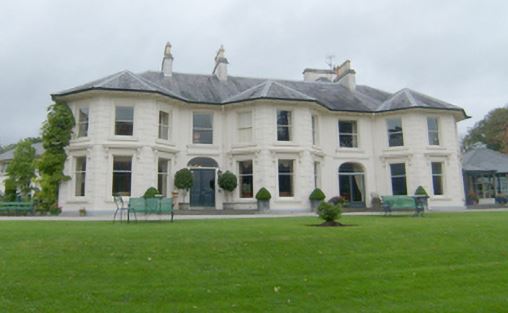
|
| Rathneaveen | No house is named on the first edition Ordnance Survey map for this townland, however later maps show Rathneaveen House. It was built in the mid 19th century as Michael Ryan occupied a house valued at £10.15 shillings in this townland at the time of Griffith's Valuation. Michael Ryan of Rathneaveen is recorded in the 1870s and the house is still extant. | |
| Rathorp | Lewis records Ratope as the residence of the late J. Foster. At the time of Griffith's Valuation it was in the possession of Patrick Geoghegan who held the property from the Marquess of Thomond and 526 acres. The house was valued at £7.10 shillings. A house still exists at the site. |
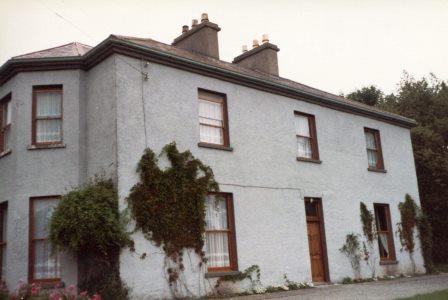
|
| Rathowen | In 1786 Wilson refers to a house which he calls "Rathrone", a mile and a half West of Killala, which was part of the estate of the Bishop of Killala. At that time it was occupied by James Rogers, though Wilson indicates it was the property of Rev. G. Rogers, Chancellor of Dromore. Most of the townland was in the possession of William Kirkwood, leasing from Harriett Gardiner, at the time of Griffith's Valuation. The house is no longer extant. | |
| Rathpeacon House | At the time of Griffith's Valuation, Rathpeacon House was occupied by William le Fanu leasing from Richard Thomas when the house was valued at £27. In the 1870s it is recorded as the residence of John Davis. | |
| Rathpeak House [Woodpark Lodge] | Owen Lynch was occupying the house at Rathpeak at the time of Griffith's Valuation when it was valued at £14. Lewis records Woodpark as his seat in 1837. This is also the property listed as his residence in 1814. At the time of the first Ordnance Survey in 1837 the house, known as Rathpeak House, is described as "a fine house, three stories high and in tolerable repair". When the property was advertised for sale in the Landed Estates' Court in 1861 Woodpark Lodge was described as a mansion house which originally cost several thousand pounds to build. There is now no sign of the house and there are modern farm sheds at the stables. Family history sources suggest the house was demolished in the latter years of the twentieth century. |
![Photo of Rathpeak House [Woodpark Lodge]](https://landedestates.ie/storage/img/orig/2807.jpg)
|
| Rathpoge | At the time of Griffith's Valuation, Sir William Godfrey was leasing this property to William Hickson. No house is marked in this area on the Ordnance Survey map, the only buildings being the Kilcolman farmyard. The buildings on the site were valued at £13. It was still in the possession of the Godfrey estate in 1906 with the same valuation but are no longer extant. | |
| Rathroe | Hajba records a lease of Rathroe House from Sir Robert Deane to Denis McCarthy dated 1779. In 1837 another Denis McCarthy was occupying the house and he was also resident in the early 1850s when the house was held from the Reverend Nicholas Chinnery. The buildings were valued at £26.15 shillings. Hajba writes that the McCarthys continued to live in the house until it was sold in the 1930s to Con Meaney TD. The house is no longer extant. | |
| Rathronan House | A property granted to John Walsh in 1679. Lewis describes this house as the "elegant residence of Major General Sir Hugh Gough". Viscount Gough was still resident in the mid 19th century when the buildings were valued at £47+ and held from Major William M. Hamerton. This property was in the possession of the Whalley family in the late 19th century. A house is still extant at the site. | |
| Rathtermon | Taylor and Skinner indicate Rathtermon as a seat of the Fleming family in 1783. In 1837 Lewis records Rathtermon as the seat of J. Flanagan. At the time of Griffith's Valuation, Rev. John Flanagan was leasing a property valued at £10 together with over 200 acres at Rathtermon, barony of Coolavin, to Phillip McDermott. Rathtermon is still the focus of a large farming enterprise. |

|
| Rathurles | Rathurles was the home of the Brereton family in the 19th century. Occupied by John Brereton in 1814 and T. Brereton in 1837. In 1840 the Ordnance Survey Name Books refer to it as "a modern building". Thomas Brereton was still resident at the time of Griffith's Valuation holding the property valued at £27.15 shillings from Patrick Kernan. Home of Hugh Finch in the 1870s. This house is still extant and occupied. |
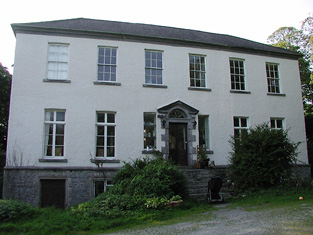
|
| Rathville | At the time of Griffith's Valuation, John Blake was the holder of a property at Carrowreagh, barony of Athenry, valued at £10. Rathville House is still extant and occupied. In 2013 it was offered for sale. |

|
| Ratra House & Stables | Lord de Freyne held a house valued at £4 10s at Ratra, barony of Frenchpark, at the time of Griffith's Valuation. In 1814 Ratra was the residence of Henry Irwin. A house, labelled Ratra, is shown on the 1st edition Ordnance Survey map. A larger building, on a different site, is labelled Ratra House on the later 25-inch edition [M684939]. Neither of these house are extant now. Offices, the property of Lord de Freyne's estate and valued at £7 10s, were located at Clashcarragh, barony of Frenchpark, at the time of Griffith's Valuation. |

|
| Rattoo A | Wilson Gun was leasing a property to John Hanlon at the time of Griffith's Valuation, when it was valued at £8 10s. This may be the building shown on the Ordnance Survey maps adjacent to the area known as The Paddock and not far from the farmyard. Buildings are still extant at these locations. | |
| Rattoo House | At the time of Grffith's Valuation, Rattoo House, in the possession of Wilson Gun, was valued at £20. Lewis refers to Rattoo Lodge as the residence of W.T. Gun in 1837. This would appear to be the house which Bary states was built by Wilson Gun in 1836. The 1st editon Ordnance Survey map, however, indicates "Rattoo House (in ruins)", south west of the Round Tower, which would suggest there was an earlier house also known by this name. In 1906 it was owned by William T.J. Gun and valued at £63. The house remained in the Gun family and their descendents until the early twentieth century when it was sold to the Land Commission by Ella Browne, grand-daughter of Wilson Gun. The Irish Tourist Association Survey, however, still describes it as in her possession "a large straggling building with fourteen bedrooms and fine sittingrooms". It is still extant and occupied. In 2010 it was offered for sale. |

|
| Ravenswood or Monroe House | Michael Roberts was leasing this property to Ralph Westropp at the time of Griffith's Valuation, when it was valued at £38. On the 1st edition Ordnance Survey map it is labelled Monroe House but later came to be known as Ravenswood House. Monroe House appears at a different location (W715627) on the 25-inch Ordnance Survey Map of the 1890s. Ravenswood was occupied by the Westropp family until the twentieth century. |

|
| Rawleystown Court | Lewis writes that "in the parish of Cahercorney are the remains of Raleighstown, an ancient building erected by the uncle of Sir Walter and afterwards the property of the Croker family, who built a splendid house here, now in ruins". The Ordnance Survey Name Book states that the house was built about 75 years previously by the Crokers and that it was afterwards sold to one of the workmen employed in building it who immediately destroyed it. In 1786 Wilson refers to "Rawlen's-town/Rawleigh's-town" as a seat of the Croker family. The first Ordnance Survey map marks the house as a ruin. | |
| Raymoghy | William Montgomery was leasing this property from James Law at the time of Griffiths Valuation in the 1850s, when it was valued at £10. The site is now occupied by farm buildings. | |
| Rea | William Talbot Crosbie's estate owned this property at the time of Griffith's Valuation, when it was valued at £5 15s. The original house is not extant now. | |
| Red Castle (Inishowen) | James S. Doherty held the property known as Red Castle in fee at the time of Griffiths Valuation in the 1850s, when it was valued at £40. In 1837 Lewis referred to Red Castle as the residence of Atkinson Wray. Buildings at the site are labelled Red Castle on all editions of the Ordnance Survey map. By 1906 it was the property of E. Cochrane. The building complex in Redcastle Demesne, was divided between the townlands of Carrickmaquigley and Tullynavinn and valued at £48. The Red Castle Hotel is now located at this site. | |
| Red Castle Villa | Catherine Doherty was occupying Red Castle Villa at the time of Griffiths Valuation in the 1850s, when it was valued at £24. It is no longer extant. | |
| Red Castle Villa | Catherine Doherty was occupying Red Castle Villa at the time of Griffiths Valuation in the 1850s, when it was valued at £24. It is no longer extant. |

